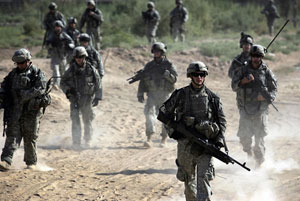

Vol. 71/No. 35 September 24, 2007

|
| Getty Images/David Furst |
| U.S. occupation troops patrol Tigris River south of Baghdad September 4. |
In hearings September 10-11, Petraeus and the U.S. ambassador to Iraq, Ryan Crocker, outlined the results of the military escalation Washington began there in January. Reflecting the lack of an alternative course offered by any wing of the U.S. ruling class, the two recommended staying the course and delaying any decisions on cutting troop levels until next year. Washington is trying to establish a stable government in Iraq that can protect its interests in the region.
“There are no easy answers or quick solutions,” said Petraeus. “A premature drawdown of our forces would likely have devastating consequences.”
There are currently 168,000 U.S. troops in Iraq. The number of daily patrols by U.S. and Iraqi forces has gone up from 1,000 to 4,500 since August 2006.
In addition, 40,000 Sunni fighters—many militia members formerly at odds with occupation forces who have since turned against al-Qaeda—are now working with U.S. and Iraqi forces. The enlistment of local tribal sheiks has resulted in military gains for Washington. Petraeus attributed a decline in bombings and sectarian killings in the last two months to a series of offensive operations carried out by U.S. and Iraqi government troops since January. He said U.S. forces have killed or captured nearly 100 al-Qaeda leaders and 2,500 al-Qaeda fighters in Iraq.
“The military objectives of the surge are, in large measure, being met,” said Petraeus.
But Crocker acknowledged that efforts to stabilize the political situation there have fallen short.
A September 4 New York Times op-ed piece noted, “there is military momentum for combined American-Iraqi forces and there is political paralysis in Baghdad.” According to a chart published in the same issue, the number of Iraqis supporting a strong central government has declined to 55 percent from 85 percent in August 2003.
Petraeus told Congress that the deployment of 30,000 additional troops to Iraq since January has set the stage for reducing the forces to “the pre-surge level of brigade combat teams by next summer.” But he said “it would be premature to make… recommendations on the pace” of further reductions.
He said that as many as 5,000 troops—1 of 20 U.S. combat brigades in Iraq—could be withdrawn by mid-December given the “progress” made so far. The proposal helps in part to deflect factional critiques by Democrats in Congress who, as part of their anti-Bush posturing, have requested timetables for troop withdrawal.
Democrats in Congress used the hearings to attack the Bush administration’s course in Iraq. They complained that recent reports show the Iraqi government has not met “benchmarks” outlined by Congress when it approved $100 billion to fund the wars in Afghanistan and Iraq last June. The bill authorized the funds regardless of whether Baghdad meets these benchmarks.
“It is very clear that every one of those reports, every one of them without exception, does not accomplish what the president promised the surge would do, and that is bring about political stability in Iraq,” said Senate majority leader Harry Reid.
“The troops in Iraq are not available for other missions; to go into Afghanistan to pursue Osama bin Laden,” said Ike Skelton, a Democratic congressman from Missouri and the chairman of the House Armed Services Committee.
Related articles:
Troops out of Iraq, Afghanistan now!
UK to raise troop levels in Afghanistan
Front page (for this issue) |
Home |
Text-version home